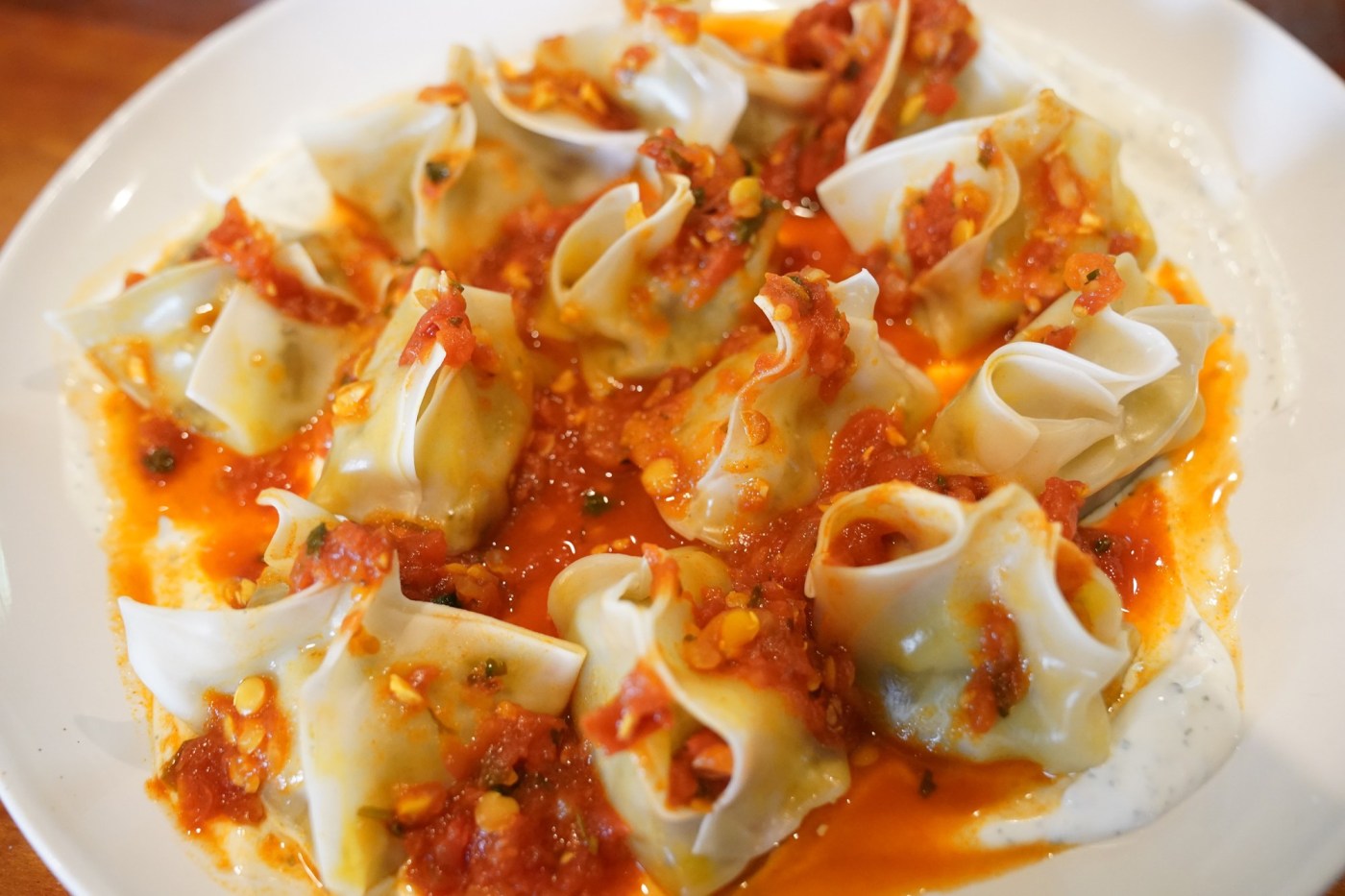
Afghan mantu are easy to make and steam in your home kitchen
Gretchen McKay | Pittsburgh Post-Gazette (TNS)
PITTSBURGH — If you don’t know a lot about Afghan cuisine, it’s understandable.
Related Articles
Make the juiciest steak with this hot restaurant trick
Surprise guests this summer with these 3 easy sides
This easy party menu makes summer classics extra special
Got ice cream? Got beer? Here’s how to make the best beer float this summer
Gretchen’s table: Coffee-rubbed steaks for just two are worth celebrating
Yet many of its flavors and ingredients are familiar to those who enjoy foods from other cultures, and a few traditional Afghan dishes could even be mistaken by the uninitiated for the curries, noodles, and rice and meat dishes found in China, India and parts of the Mediterranean.
One plump and delicious example is the savory dumpling known as mantu.
A variation of the steamed Chinese dumpling or Korean mandoo, the hand-rolled dough bundles piled high on platters in Afghanistan are stuffed with ground meat and vegetables (usually onion), and served with two toppings: a tangy yogurt sauce kissed with garlic and dried mint and tomato-based sauce spiced with turmeric and chili.
As relayed in “Parwana: Recipes and Stories from an Afghan Kitchen” by Durkhanai Ayubi (Interlink Books, $35), mantu are thought to have originated in Central Asia, in territories that belonged to the Mongolian Empire. The dumpling then traveled to Turkey and, as it grew in popularity, made its way via the fabled Silk Road into Afghanistan, where it was adapted to local palates and culture.
Today, mantu offer not just a warm and gently spiced taste of Afghanistan, with prized spices such as chili, turmeric, cumin, pepper and nutmeg at the forefront, but also an expression of the country’s hospitality.
“The highest tenet of eating in Afghanistan,” Ayubi writes, “perhaps its holy grail, is the hospitality that surrounds it. Unexpected guests are treated with the utmost care and attention; even those who have very little to share will ensure their guests are always treated to the best.”
Folded by hand into snug, flower bud-like dumplings, mantu often are made for special occasions such as birthdays and holidays because they’re pretty labor-intensive. Their intricacy — the dough wrappers shouldn’t overpower the filling, and vice versa — also it can take many tries before the process is burned into muscle memory, even for those who started learning at their mother’s side as children.
Mastoorah Fazly, who immigrated to Pittsburgh in 2016 and now helps run the Afghan-owned catering company Zafaron, watched and learned the art of mantu making from her mother, Nafas Gul, as a girl in Afghanistan. But she didn’t make them on her own until she was about 18 — with help from YouTube videos and that gift to busy cooks, commercially made dumpling wrappers.
“Most people want to make a good shape,” the 34-year-old says. That takes some finger finesse.
Afghans enjoy food with different influences, Fazly says, but the county’s most popular meal is also its national dish: Kabuli pulao, a beautiful and balanced rice dish made with carrots, raisins, almonds, pistachios and a delicate blend of spices. But mantu, which are often made with family and friends, are a very close second.
Fazly doesn’t hesitate when asked why dumplings are such a popular Afghan food.
“In my eye, it’s a good food, and it’s also a traditional food from a long, long time ago in Afghanistan,” she says. “And it’s very delicious!”
Ground beef is most commonly used in the filling, but ground lamb is also popular. Whatever the cook chooses, the meat is gently perfumed with traditional Afghan spices that might include coriander, curry, turmeric, black pepper and/or cumin, depending on the family recipe.
While home chefs in every part of the country make mantu, “everybody has their own special way to cook it,” Fazly explains. She, for instance, uses only seasoned ground chicken as filling when cooking for her immediate family because her kids don’t like red meat.
Her clients at Zafaron, conversely, can expect ground beef or lamb.
The business grew out of a sewing class Fazly participated in when she moved here, followed by a 2019 interactive cultural/culinary performance piece curated by actor and playwright Molly Rice called “Khūrākī,” which means “eat” or “meal” in the Dari language.
Some Afghan cooks still make mantu dough the old-fashioned way — by hand — if they have time. They sometimes use a pasta maker, Fazly says, because recipes call for it to be rolled out in big, super-thin sheets that are then cut into squares.
But really, unless dough-making is an occasion in itself, most take advantage of ready-to-use wrappers because scratch dough requires serious time. “And these days, everything is easy,” Fazly admits.
That certainly goes for the traditional white (yogurt) and red (tomato-based) sauces that add layers of flavor and richness to a platter of dumplings. Both are so simple they can be prepared while the mantu are steaming.
They’re not an “everyday” food, but the Whitehall resident says she makes the dumplings at least once or twice a month, and more often as a side dish if they’re having friends over or throwing a party. Her 10-year-old daughter, who loves to cook, usually helps her.
“But my son? He just likes to eat!” she says, laughing.
Fazly says her daughter often makes her own shapes instead of the traditional flower bud-like bundles a seasoned cook strives for.
“She’ll ask, ‘Mom, is it necessary to be like your shape?’ And I say, ‘Yes, if you can.’ “
But no matter what they end up looking like, she says they all taste the same — delicious.
Pre-recipe tips
Ready to try mantu in your own kitchen? Here are some tips:
—If you’re ambitious, you can make wrappers from scratch by hand or in a stand mixer. (All you need is flour, water and oil.) Roll the pastry out into a paper-thin rectangle and then cut it into 4-inch squares.
But be forewarned: The process is tricky and takes some practice to master. It’s also incredibly time-consuming. Pre-made dumpling wrappers are available in any Asian market or larger grocery store are more practical for beginners.
—To cut down on time, make a party of it by enlisting family members or friends to help fill and fold.
—Since this recipe makes dozens of mantu, you will need a large steamer pot to steam them. (A two-tier stainless-steel steamer at Oriental Market off McKnight Road in Ross costs $45.99.)
—For a smooth, lump-free filling, use a food processor to finely mince the onions.
—While assembling, be sure to cover both the wrappers and filled dumplings with a damp cloth or plastic wrap so that they don’t dry out before cooking.
—Make sure the mantu are not touching each other in the steamer, or they could end up sticking together. You also need to lightly oil the basket to prevent the bottoms from sticking.
—Cooking for a party or other event? Both the filling and sauces can be made a day or so ahead so all you have to do on the day of is fill, fold and steam the dumplings.
—To keep cooked mantu warm until serving, place in a warm oven covered with a sheet of oiled aluminum foil.
—While mantu are traditionally filled with ground meat, it’s OK to go vegetarian. The filling in Ayubi’s recipe is made with carrot, cabbage and sautéed onion.
—After saucing the dumplings, add a garnish. Cilantro or fresh mint is ideal if you have it, but you can use chopped parsley in a pinch. “Just something green for a good mix of decoration,” says Fazly.
Ingredients for Afghan Mantu dumpling sauce. Wednesday, May 8, 2024. (Sebastian Foltz/Pittsburgh Post-Gazette/TNS)
Afghan mantu
PG tested
This recipe makes about 50 mantu. I used ground lamb and pre-made wrappers.
For filling
2 tablespoons vegetable oil
3/4 pound ground lamb or beef
2 cups diced onion
3 garlic cloves, minced
Salt to taste
2 teaspoons cumin
2 teaspoons ground coriander
1 teaspoon chili powder
1/4 teaspoon turmeric
1/4 teaspoon cardamom
Generous pinch of nutmeg
2 tablespoons chopped cilantro
1 package wonton wrappers or homemade mantu dough
For mint sauce
1 cup plain yogurt
1 tablespoon dried mint, or to taste
1 clove garlic, minced
Salt to taste
For sauce
1 tablespoon oil
1/4 cup diced onion
2 tablespoons tomato paste
2 tomatoes, chopped, with juice
1/8 teaspoon turmeric
1/4 teaspoon chili powder
1 clove garlic, minced
2 teaspoons chana daal (yellow split peas) soaked overnight
Salt to taste
Wet edge of Afghan Mantu dumplings before folding. (Sebastian Foltz/Pittsburgh Post-Gazette/TNS)
In large saucepan over medium heat, heat the oil. Add ground lamb or beef to the hot pan and break into large pieces with a wooden spoon or spatula. Cook, stirring often, until meat is browned.
Add salt and diced onions, and continue cooking until onions soften and cook down, 3-4 minutes.
Now add spices and stir to combine well. Cook seasoned meat and onion mixture for a few minutes, then taste and adjust seasonings.
Stir in cilantro, then set aside to cool.
Once it has cooled, it’s time to fill the wrappers. Place a wrapper in your nondominant hand and spoon a generous spoonful of cooled filling into the center. Using your finger, brush the edges with water.
Pick up two diagonally opposite corners and bring together over filling, then pinch to seal. Repeat with the other two corners so you have a small, sealed, square-ish parcel. Then, bring the ends together to create an almost oval parcel with two ends pinched together. (It will resemble a flower bud.)
Cover with plastic wrap or a damp dish towel (to keep dumplings from drying out) and continue with remaining ingredients.
When ready to cook, boil water in the bottom of a large steamer. Lightly coat the steamer tray with oil or nonstick spray. Gently add mantu, one at a time, making sure they do not touch. (They will expand slightly while cooking.)
Steam in batches for 10-15 minutes, or until the wrappers are slightly translucent and feel firm.
While dumplings are steaming, make yogurt and tomato sauces.
Combine yogurt, mint and minced garlic in a small bowl. Add salt to taste and adjust seasoning, if desired. If it’s too thick, thin with a bit of water. Set aside.
Make tomato sauce. Add 1 tablespoon of oil to a large saucepan and heat until sizzling. Add onion and saute until translucent, about 2 minutes.
Add tomato paste, and allow it to cook down for a minutes or so to caramelize. Add chopped tomatoes with juice and turmeric, chili powder and garlic and stir to combine. Add a little water and bring to a simmer, then stir in the chana daal and season to taste with salt.
To serve, spread a layer of yogurt sauce on a large serving platter. Top with steamed mantu, then more yogurt sauce and then the tomato-lentil sauce. If desired, drizzle a little olive oil on top and sprinkle with dried mint.
Serves a crowd.
— adapted form fatimasfabulouskitchen.com
©2024 PG Publishing Co. Visit at post-gazette.com. Distributed by Tribune Content Agency, LLC.

